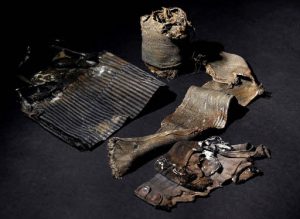Silent Witness: Clothing and socks of student carried to Army Clothing Depot Building torn to pieces by A-bomb’s thermal rays
Apr. 19, 2021
by Miho Kuwajima, Staff Writer
Only scraps of burnt trousers and his jikatabi (mitten-style, rubber-soled socks) remained after the wearer experienced the atomic bombing, speaking volumes about the damaging thermals rays generated in the bombing. The clothes and shoes were worn by Yoshiharu Kinoshita, then 13 and a first-year student at Sanyo Industrial School (now Sanyo High School), at the end of his life. After the atomic bombing, Mr. Kinoshita was carried to the former Army Clothing Depot Buildings, used as a makeshift first-aid station and located in Hiroshima’s Deshio-cho area (present-day Minami Ward), but he died the same day.
Mr. Kinoshita experienced the atomic bombing while engaged in the dismantling of buildings for the creation of fire lanes in the area of Zakoba-cho (present-day Naka Ward), about 1.2 kilometers from the hypocenter, suffering burns over his entire body. His father, Hawaichi Kinoshita, then 47, walked around visiting national schools and temples to which injured victims were being admitted, in a search for his son that lasted well into the night. Despite his physical and psychological exhaustion, Hawaichi determined to visit one last spot, arriving at the Clothing Depot Buildings in the evening of August 7.
On his way upstairs to the second floor of one of the buildings, his eyes happened on labels attached to a body on a stretcher with the information “Yoshiharu Kinoshita” and “Yagi Village, Asa-gun.” Although the body was completely wrapped in bandages, he knew it was his son. The body was just about to be cremated.
In the early morning of August 8, Hawaichi brought his son’s body home with his clothes and socks, which in 1972 were donated to the Hiroshima Peace Memorial Museum by Katsuyuki Kinoshita, 87, Hawaichi’s third son who lives in the city’s Asaminami Ward. After the museum’s permanent exhibits were comprehensively overhauled earlier in February this year, 2022, the items left behind by Yoshiharu were added to the collective display designed to demonstrate the horrific conditions on August 6, along with artifacts from 21 other students who died in the bombing.
(Originally published on April 19, 2021)
Only scraps of burnt trousers and his jikatabi (mitten-style, rubber-soled socks) remained after the wearer experienced the atomic bombing, speaking volumes about the damaging thermals rays generated in the bombing. The clothes and shoes were worn by Yoshiharu Kinoshita, then 13 and a first-year student at Sanyo Industrial School (now Sanyo High School), at the end of his life. After the atomic bombing, Mr. Kinoshita was carried to the former Army Clothing Depot Buildings, used as a makeshift first-aid station and located in Hiroshima’s Deshio-cho area (present-day Minami Ward), but he died the same day.
Mr. Kinoshita experienced the atomic bombing while engaged in the dismantling of buildings for the creation of fire lanes in the area of Zakoba-cho (present-day Naka Ward), about 1.2 kilometers from the hypocenter, suffering burns over his entire body. His father, Hawaichi Kinoshita, then 47, walked around visiting national schools and temples to which injured victims were being admitted, in a search for his son that lasted well into the night. Despite his physical and psychological exhaustion, Hawaichi determined to visit one last spot, arriving at the Clothing Depot Buildings in the evening of August 7.
On his way upstairs to the second floor of one of the buildings, his eyes happened on labels attached to a body on a stretcher with the information “Yoshiharu Kinoshita” and “Yagi Village, Asa-gun.” Although the body was completely wrapped in bandages, he knew it was his son. The body was just about to be cremated.
In the early morning of August 8, Hawaichi brought his son’s body home with his clothes and socks, which in 1972 were donated to the Hiroshima Peace Memorial Museum by Katsuyuki Kinoshita, 87, Hawaichi’s third son who lives in the city’s Asaminami Ward. After the museum’s permanent exhibits were comprehensively overhauled earlier in February this year, 2022, the items left behind by Yoshiharu were added to the collective display designed to demonstrate the horrific conditions on August 6, along with artifacts from 21 other students who died in the bombing.
(Originally published on April 19, 2021)








